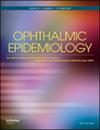Poverty and Vision: The Effect of Title 1 Status on Vision Screening Referral Rates in School-Aged Children in Western South Dakota.
IF 1.7
4区 医学
Q3 OPHTHALMOLOGY
引用次数: 0
Abstract
PURPOSE Interventions such as eye exams and glasses are used to correct visual problems that may lead to amblyopia, an irreversible decrease in visual acuity. Children with limited access to these interventions are more likely to have unaddressed visual problems that can lead to amblyopia or negatively impact school performance. This study compared vision screening results of children in schools with Title 1 or Non-Title 1 designation to investigate the link between poverty and vision. METHODS Data from KidsFIRST vision screenings conducted with the SPOTTM photoscreener performed in Rapid City Area elementary schools were compared across multiple parameters. Students were referred for eye examinations based on identifying the following problems: anisometropia, anisocoria, astigmatism, myopia, hyperopia, gaze misalignment, or a combination. RESULTS Overall, eye exam referral rates have increased since 2012 (11.9% in 2012, 19.7% in 2023), with a disproportionate increase in referrals from Title 1 schools (25.2% in 2023) vs. Non-Title 1 schools (11.9% in 2023) (p < 0.001). This is largely due to a significantly higher prevalence of astigmatism referrals in Title 1 students (20.9%) compared to Non-Title 1 students (7.5%). Although a higher percentage of Title 1 students are reported to have eye correction (24.4% vs 16.6%), only a slightly higher percentage of Title 1 students wore eye correction during screening (11.5% vs 10.5%). CONCLUSION Students at Title 1 schools may have a higher rate of amblyopia risk factors. Additional eye care-based interventions should be taken to reduce the risk of amblyopia in this population.贫困与视力:标题 1 状态对南达科塔州西部学龄儿童视力筛查转诊率的影响》(Title 1 Status on Vision Screening Referral Rates in Western South Dakota)。
目的眼科检查和配眼镜等干预措施用于矫正可能导致弱视的视力问题,弱视是一种不可逆转的视力下降。接受这些干预措施的机会有限的儿童更有可能存在未得到解决的视力问题,从而导致弱视或对学习成绩产生负面影响。本研究比较了 "头衔 1 "学校和非 "头衔 1 "学校儿童的视力筛查结果,以研究贫困与视力之间的联系。方法比较了拉皮德城地区小学使用 SPOTTM 光检仪进行的 KidsFIRST 视力筛查数据,并对多个参数进行了比较。结果总体而言,自 2012 年以来,眼科检查转诊率有所上升(2012 年为 11.9%,2023 年为 19.7%),其中来自 Title 1 学校的转诊率(2023 年为 25.2%)与非 Title 1 学校的转诊率(2023 年为 11.9%)相比增幅过大(p < 0.001)。这主要是由于 Title 1 学生的散光转诊率(20.9%)明显高于非 Title 1 学生(7.5%)。尽管 "第一学位 "学生中接受过眼部矫正的比例较高(24.4% vs 16.6%),但在筛查过程中,"第一学位 "学生中接受眼部矫正的比例仅略高于非 "第一学位 "学生(11.5% vs 10.5%)。应采取更多基于眼保健的干预措施,以降低这一人群的弱视风险。
本文章由计算机程序翻译,如有差异,请以英文原文为准。
求助全文
约1分钟内获得全文
求助全文
来源期刊

Ophthalmic epidemiology
医学-眼科学
CiteScore
3.70
自引率
5.60%
发文量
61
审稿时长
6-12 weeks
期刊介绍:
Ophthalmic Epidemiology is dedicated to the publication of original research into eye and vision health in the fields of epidemiology, public health and the prevention of blindness. Ophthalmic Epidemiology publishes editorials, original research reports, systematic reviews and meta-analysis articles, brief communications and letters to the editor on all subjects related to ophthalmic epidemiology. A broad range of topics is suitable, such as: evaluating the risk of ocular diseases, general and specific study designs, screening program implementation and evaluation, eye health care access, delivery and outcomes, therapeutic efficacy or effectiveness, disease prognosis and quality of life, cost-benefit analysis, biostatistical theory and risk factor analysis. We are looking to expand our engagement with reports of international interest, including those regarding problems affecting developing countries, although reports from all over the world potentially are suitable. Clinical case reports, small case series (not enough for a cohort analysis) articles and animal research reports are not appropriate for this journal.
 求助内容:
求助内容: 应助结果提醒方式:
应助结果提醒方式:


